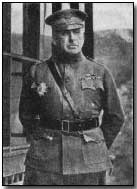Who's Who - Leonard Wood
 Leonard Wood (1860-1927) prepared the
U.S. army for its eventual entry into the First World War in 1917 by serving
as its Chief of Staff from 1910-14.
Leonard Wood (1860-1927) prepared the
U.S. army for its eventual entry into the First World War in 1917 by serving
as its Chief of Staff from 1910-14.
Wood was born on 9 October 1860 in Winchester, New Hampshire, the son of a doctor. Entering Harvard Medical School in 1880 he graduated in 1883 and determined to take up a career within the U.S. army, initially as a contract physician in 1885.
Wood served as a member of the expedition that conducted the army's final campaign against the legendary American Indian fighter Geronimo.
Wood's medical service led to a succession of varied appointments, including acting as personal physician to President McKinley. In 1898 he was awarded the Medal of Honor in recognition of his gallantry and services to the army.
War with Spain in 1898 saw Wood request a line command; in due course he was rewarded with command of the 1st Volunteer Cavalry Brigade; his second in command was Theodore Roosevelt. Wood's regiment subsequently developed a popular reputation as the "Rough Riders". Having led his men at Las Guasimas and San Juan Hill Wood saw out the remainder of the campaign at the head of 2nd Cavalry Brigade.
Remaining in Cuba at the end of the war, Wood acted as its Military Governor until 1902, during which time he instituted a series of political, social and educational reforms. Prior to his return to the U.S. Wood was promoted Brigadier-General.
By now accustomed to command positions Wood served in various leadership roles upon his departure from Cuba, including command of the Philippines Division and as the head of the Department of the East. His ultimate appointment, which came in 1910, was as army Chief of Staff: the only medical officer to hold the position.
As at Cuba earlier Wood instituted numerous reforms as Chief of Staff, strengthening the General Staff (and his own position) and reducing the role of the somewhat conservative bureau system (which acted chiefly to hinder army reform). He also developed the Manoeuvre Division and the concept of the Mobile Army.
Having thus laid the groundwork for America's eventual participation in World War One, Wood was replaced as Chief of Staff in 1914 by John Pershing. Wood himself returned to the Department of the East and campaigned ceaselessly for an official policy of military preparedness (founding the Preparedness Movement in 1915), a campaign that did not endear him to the current Democrat administration overseen by President Woodrow Wilson.
It also ensured that he would not be assigned a prominent role when the U.S. finally entered the war in April 1917, passed over by both Pershing and Secretary of War Newton Baker. Instead Wood was reduced to training the 89th and 10th Infantry Divisions for service in France.
A Republican with broad party support, Wood lobbied for his party's presidential nomination after the war; in the event however the nomination went to Warren Harding on the tenth ballot; Harding subsequently won the 1920 presidential election.
Retiring from the army in 1921 Wood was appointed by Harding as Governor General of the Philippines, a post to which he was ideally suited. He held the position until shortly before his death in Boston on 7 August 1927 from a brain tumour.
A "Bangalore Torpedo" was an explosive tube used to clear a path through a wire entanglement.
- Did you know?
